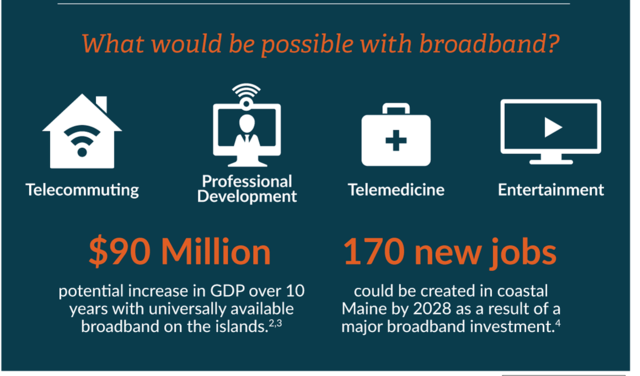Internet speeds for Maine’s year-round island communities are hampering economic growth and even threatening their long-term viability, a report issued Dec. 9 asserts.
The 200-page report by Tilson Technology followed extensive study of current Internet speeds on 14 islands: the Cranberry Isles (Islesford, Great Cranberry and Sutton), Vinalhaven, North Haven, Monhegan, Matinicus, Frenchboro, Swan’s, Chebeague, Long, Isle Au Haut, Cliff and Peaks.
Tilson’s work was commissioned by the nonprofit Island Institute, publisher of The Working Waterfront.
Among its findings is that bringing Internet speeds up to broadband levels—defined by the state’s ConnectME Authority as a minimum speed of 10 Mbps of upload and download—could grow island economies by $90 million over ten years.
Establishing broadband speeds on the islands could create 170 jobs along the coast and on the islands by 2028, the report concluded, which would produce $9 million in additional tax revenue.
“Broadband represents one of the most effective ways to address the access challenges associated with island life,” according to Tilson. “Superior connections can provide economic, educational, medical and other benefits without the need for physical connectedness.”
The scope of the study included hosting public meetings on the islands, creating an inventory of current Internet technology, surveys to gauge attitudes about current service and possible upgrades, cost estimates for improvements, and business and operational models for island-based systems.
The Island Institute hosted a conference in November of island stakeholders on the challenges and possibilities of broadband.
Briana Warner, the Island Institute’s economic development director, said the nonprofit commissioned the study and report in response to islander concerns.
“We wanted to answer community questions around improved Internet, broadband capabilities,” she said. “We did this because a lot of people were citing this as a need.”
As bad as the Internet speeds on the islands are—all are below the 10 Mbps threshold, a standard about 94 percent of Americans have accesss to—they are not an outlier for the state. Maine has been ranked 49th among U.S. states for Internet speeds.
But the islands pose special challenges for improving speeds. Not only do most have small year-round populations, but getting the service across the water has discouraged private providers from investing in upgrades.
The Tilson report suggests there probably won’t be a standard fix for islands. Different topographies, distances from the mainland and current infrastructure will likely dictate different solutions.
Islands that are part of the same municipality, like those that are part of the Cranberry Isles town, or islands in close proximity, like those in Casco Bay or like Vinalhaven and North Haven, could share infrastructure, the report notes.
Among the fixes considered viable are:
- Fiber to each user, which offers high speeds, universal same-speed access, and lower cost upgrades; but bringing and distributing fiber on an island cost millions of dollars, Tilson notes.
- Wireless service, much like that used by cell phones, would rely on 150-foot towers, which may be opposed on aesthetic grounds. Such technology also is hampered by trees and hills.
- Existing private providers like FairPoint and TDS are planning upgrades on Matinicus, Frenchboro and Isle au Haut and new service on Chebeague, the report notes. To date, though, those private companies have not offered other islands upgraded infrasctucture.
Two of Maine’s year-round islands have taken matters into their own hands. Chebeague created a municipal broadband network and has been upgrading it to broadband levels. Islesboro is currently studying the possibility of building a municipally owned system.
The report provided individualized options for each island, but stopped short of making recommendations.





